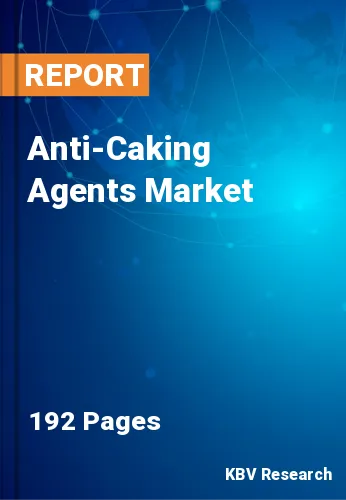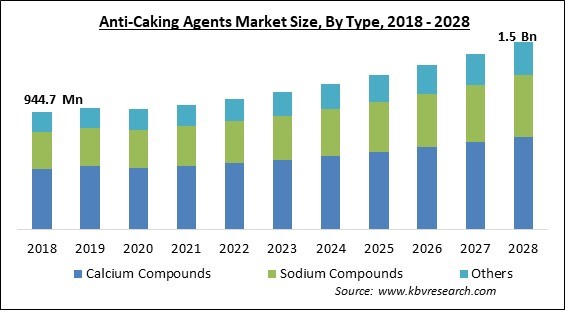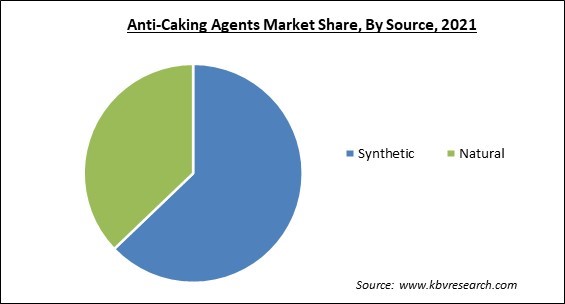
The Global Anti-Caking Agents Market size is expected to reach $1.5 billion by 2028, rising at a market growth of 6.2% CAGR during the forecast period.
Anti-caking agents are anhydrous substances that are added sparingly to dry foods to avoid particle clumping and promote free-flowing drying. Anticaking chemicals function by soaking up extra moisture and coating particles to make them more water-repellent. It will be more challenging to use the premix for manufacturing without the release agent since dry soup, cake, and cookie mix will clump up and the cappuccino and hot chocolate machines won't function properly.

For example, table salts, baking powders, flour combinations, cocoa, and blended coffee drinks all frequently contain release agents. The production rates can be decreased by adding anti-caking chemicals during manufacture to eliminate bridging throughout the packaging process. When particles interact or unite to build a bridge or arch throughout the outlet of a container, like a hopper, silo, or mixing tank, this is known as powder bridging.
Anti-caking compounds used in food provide a number of advantages for our health. For those with delicate digestive systems, arrowroot is a good anti-caking agent, while agar-agar helps people with diabetes mellitus control their blood sugar and cholesterol levels. For instance, kuzu root assists in lowering high blood pressure, control blood sugar, cure chronic headaches, and soothe muscular tension. Cellulose gum also helps to reduce fat. Due to their ease of swallowing, patients who utilise food thickeners have a lower risk of developing dysphagia.
Food is prevented from going bad by using food preservation techniques due of enzyme and microbial activity. Food preservation extends its shelf life in a safe storage setting. Since agents are released during the off-season, food is simpler to come by. Particularly in remote or difficult-to-reach areas, there are more food options. As a result, moving food is now less complicated.
Businesses all across the world were significantly impacted by the COVID-19 pandemic. The food and beverage business were among those most severely impacted by the pandemic. Due to the pandemic, demand for processed food and other food products significantly decreased. Food production and distribution were significantly hampered by the lockdown that various governments imposed within their nations. After the COVID-19 impact, the market for food anti-caking chemicals is predicted to expand at a remarkably constant rate. Markets should operate in a regulatory environment that is unimpeded. However, the regulatory environment that favours the market for food anti-caking agents, widespread consumer acceptance, favourable trade policies, new market entrants, high investments, and little competition from substitute products, as well as the cost of ingredients, are anticipated to boost demand in the future.
Due to their critical role in preserving long shelf lives, free-flowing ability, texture, and other organoleptic properties, food ingredients like milk & cream powder, baking powder, cake mixes, and instant soup powder are anticipated to have a significant (positive) influence on the growth of food anti-caking agents. As a result, the growth in the consumption of various food ingredients has a direct effect on the increase in the consumption of food anti-caking agents.
Consumers now prioritise convenience as a result of the rise in living standards and shifts in lifestyle. Owing to the rise in demand for convenience foods with improved quality and shelf life, there is an increase in the need for food anti-caking chemicals in emerging countries. As consumers look for quick, simple, and nutritious options, fast foods are also becoming increasingly distinguished from junk food.
E-numbers for dietary supplements are allowed in food. However, many customers have a poor opinion of them. Studies have been done to evaluate the viewpoints of food professionals about the reasons behind and strategies for reducing consumer mistrust of E-numbers. Food industry experts advised consumers to pay attention to the information sources and veracity of E-number information. Food industry experts also advocated limiting negative label claims and reaching collective agreements with all parties about transparent and honest communication in order to reduce consumer mistrust.
Based on the type, the market is categorized into Others, Calcium Compounds, and Sodium Compounds. Due to the widespread use of anti-caking chemicals for retail applications, the calcium compounds segment will hold the largest market share in 2021. Salt, onion salt, garlic salt, baking powder, unstandardized dry mixes, dry cure, confectioner's sugar (Icing sugar), meat binder, grated or shredded cheddar cheese, and unstandardized grated or shredded cheese preparations are just a few of the products that use calcium compounds.

Based on source, the Anti-Caking Agents Market is categorized into Natural and Synthetic segments. Due to the introduction of novel food products, the natural segment contributed significantly in 2021. Natural anti-caking agents are compounds that come from the natural world that work to keep powdered ingredients from clumping together. Rice flour, Corn-starch, and silica gel are a few typical instances of natural anti-caking agents.
Based on the Application, the market is categorized into Seasoning & Condiments, Dairy, Bakery, and Others. Due to a significant number of consumers buying on a massive scale, the dairy category led the market in 2021. An anti-caking agent is made of fine mesh vegetable flour, cellulose, bentonite, antimycotic agents, or bacterial cultures, and lowers the stickiness of chunked, diced, or shredded cheese while enhancing cheese functionality. This anti-caking compound will also stop the formation of mould and yeast.
| Report Attribute | Details |
|---|---|
| Market size value in 2021 | USD 1 Billion |
| Market size forecast in 2028 | USD 1.5 Billion |
| Base Year | 2021 |
| Historical Period | 2018 to 2020 |
| Forecast Period | 2022 to 2028 |
| Revenue Growth Rate | CAGR of 6.2% from 2022 to 2028 |
| Number of Pages | 192 |
| Number of Tables | 349 |
| Report coverage | Market Trends, Revenue Estimation and Forecast, Segmentation Analysis, Regional and Country Breakdown, Companies Strategic Developments, Company Profiling |
| Segments covered | Type, Source, Application, Region |
| Country scope | US, Canada, Mexico, Germany, UK, France, Russia, Spain, Italy, China, Japan, India, South Korea, Singapore, Malaysia, Brazil, Argentina, UAE, Saudi Arabia, South Africa, Nigeria |
| Growth Drivers |
|
| Restraints |
|
Based on the geography, the market is bifurcated into North America, Europe, Asia Pacific, and LAMEA. The region of North America, where bakery snacks and ready-to-eat flour mixes are increasingly popular, generates the second-highest revenue share in the industry. The high consumption and ongoing demand for a wide variety of hygroscopic food components and premixes in a wide variety of food products/applications is the primary cause of the North American region's high growth.
Free Valuable Insights: Global Anti-Caking Agents Market size to reach USD 1.5 Billion by 2028
The market research report covers the analysis of key stake holders of the market. Key companies profiled in the report include Evonik Industries AG (RAG-Stiftung). PPG Industries, Inc., Agropur Dairy Cooperative, Huber Engineered Materials (J.M. Huber Corporation), Kao Corporation, Solvay SA, Univar Solutions, Inc., Cabot Corporation and Brenntag SE .
By Type
By Source
By Application
By Geography
The global Anti-Caking Agents Market size is expected to reach $1.5 billion by 2028.
Increasing use of food ingredients are driving the market in coming years, however, Lack of trust among consumers with regards to E-numbers restraints the growth of the market.
Evonik Industries AG (RAG-Stiftung). PPG Industries, Inc., Agropur Dairy Cooperative, Huber Engineered Materials (J.M. Huber Corporation), Kao Corporation, Solvay SA, Univar Solutions, Inc., Cabot Corporation and Brenntag SE.
The Synthetic market is leading the segment in the Global Anti-Caking Agents Market by Source in 2021; thereby, achieving a market value of $932.1 million by 2028.
The Europe market dominated the Global Anti-Caking Agents Market by Region in 2021; thereby, achieving a market value of $525.8 million by 2028.
Our team of dedicated experts can provide you with attractive expansion opportunities for your business.
